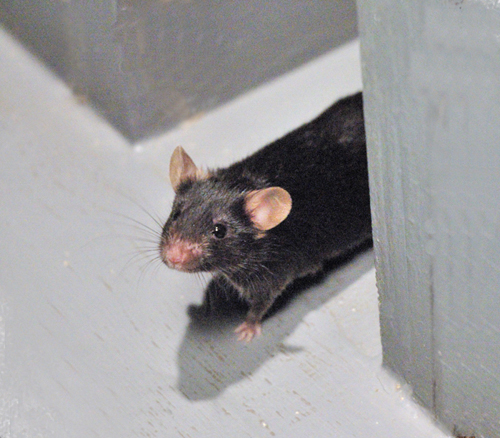Archived Content
The National Institute of Mental Health archives materials that are over 4 years old and no longer being updated. The content on this page is provided for historical reference purposes only and may not reflect current knowledge or information.
Impaired Brain Connections Traced to Schizophrenia Mutation
Like Patients, Engineered Mice Falter at Working Memory Tasks
• Press Release
The strongest known recurrent genetic cause of schizophrenia impairs communications between the brain's decision-making and memory hubs, resulting in working memory deficits, according to a study in mice.
"For the first time, we have a powerful animal model that shows us how genetics affects brain circuitry, at the level of single neurons, to produce a learning and memory deficit linked to schizophrenia," explained Thomas R. Insel, M.D., director of the National Institute of Mental Health (NIMH), part of the National Institutes of Health. "This new research tool holds promise for ultimately unraveling the underlying anatomical connections and specific genes involved."
NIMH grantees Joshua Gordon, M.D., Ph.D., Joseph Gogos, M.D., Ph.D., Maria Karayiorgou, M.D., and Columbia University colleagues, report on their discovery in genetically engineered mice in the April 1, 2010 issue of the journal Nature.
"Our findings pinpoint a specific circuit and mechanism by which a mutation produces a core feature of the disorder," said Gordon, who led the research.
Researchers have suspected such a brain connectivity disturbance in schizophrenia for more than a century, and the NIH has launched a new initiative on the brain's functional circuitry, or connectome. Although the disorder is thought to be 70 percent heritable, its genetics are dauntingly complex, except in certain rare cases, such as those traced to the mutation in question.
Prior to this study, neuroimaging studies in schizophrenia patients had found abnormal connections between the brain's prefrontal cortex, the executive hub, and the hippocampus, the memory hub, linked to impaired working memory. It was also known that a mutation in the suspect site on chromosome 22, called 22q11.2, boosts schizophrenia risk 30-fold and also causes other abnormalities . Although accounting for only a small portion of cases, this tiny missing section of genetic material, called a microdeletion, has repeatedly turned up in genetic studies of schizophrenia and is an indisputable risk factor for the illness.
Still, the mutation's link to the disturbed connectivity and working memory deficit eluded detection until now.
To explore the mutation's effects on brain circuitry, Gogos, Karayiorgou and colleagues engineered a line of mice expressing the same missing segment of genetic material as the patients. Strikingly, like their human counterparts with schizophrenia, these animals turned out to have difficulty with working memory tasks – holding information in mind from moment to moment.
Successful performance of such tasks depends on good connections in a circuit linking the prefrontal cortex and the hippocampus. To measure such functional connections, Gordon and colleagues monitored signals emitted by single neurons implanted in the two distant brain structures while mice performed a working memory task in a T-maze (see below).
The more in-sync the neurons from the two areas fired, the better the functional connections between the two structures – and the better the mice performed the task. Moreover, the better the synchrony to start with, the quicker the animals learned the task. The more synchrony improved, the better they performed.
As suspected, the mice with the chromosome 22 mutation faltered on all counts –– showing much worse synchrony, learning and performance levels than control mice.
"Our results extend beyond those in patients by showing how an undeniable genetic risk factor for schizophrenia can disrupt connectivity at the level of single neurons," explained Gordon.
The researchers plan to follow up with studies into how the mutation affects brain anatomical and molecular connections and the workings of affected genes.
The research was also funded by the Simons Foundation.

Mouse at the decision point in the T-maze. To get a reward, a mouse had to remember whether it had turned left or right on the previous trial and turn in the opposite direction. Mice genetically engineered to lack a specific segment of genetic material on Chromosome 22, a known cause of schizophrenia, like patients with the disorder, faltered at such working memory tasks because of poor functional connections between the brain's executive and memory hubs.
Reference
Impaired hippocampal-prefrontal synchrony in a genetic mouse model of schizophrenia . Sigurdsson T, Stark KL, Karayiorgou M, Gogos JA, Gordon JA. Nature. 2010 Apr 1;464(7289):763-7. PMID: 20360742
About the National Institute of Mental Health (NIMH): The mission of the NIMH is to transform the understanding and treatment of mental illnesses through basic and clinical research, paving the way for prevention, recovery and cure. For more information, visit the NIMH website.
About the National Institutes of Health (NIH): NIH, the nation's medical research agency, includes 27 Institutes and Centers and is a component of the U.S. Department of Health and Human Services. NIH is the primary federal agency conducting and supporting basic, clinical, and translational medical research, and is investigating the causes, treatments, and cures for both common and rare diseases. For more information about NIH and its programs, visit the NIH website .
NIH…Turning Discovery Into Health®
